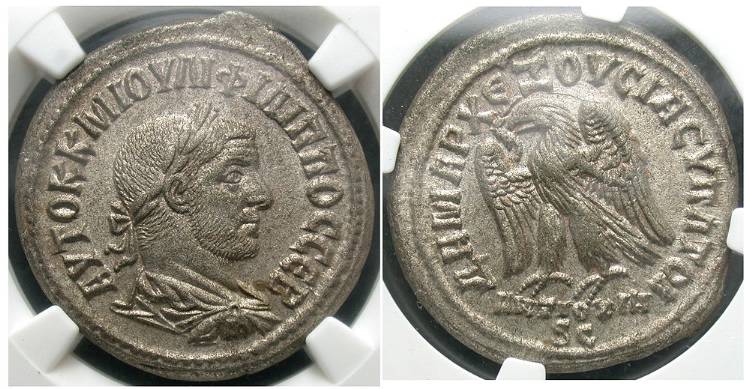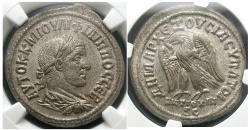Lot 158: Syria, Seleucis and Pieria. Antiochia ad Orontem. Philip I. A.D. 244-249. BI tetradrachm. Cos. IV (A.D. 248/9). 
AUCTION: Triskeles - Auction 13 (Auction 313)

- Sold Winning Bid: $160
- 2 Bid(s)
Syria, Seleucis and Pieria. Antiochia ad Orontem. Philip I. A.D. 244-249. BI tetradrachm (27 mm, 12.58 g, 7 h). Cos. IV (A.D. 248/9). AVTOK K M IOVΛI ΦIΛIΠΠOC CЄB, laureate, draped, and cuirassed bust of Philip I right / ΔHMAΡX ЄΞOVCIAC VΠA TO Δ, eagle, wings displayed, standing left, holding wreath in beak; in exergue, ANTIOXIA/S C in two lines. McAlee 935; Prieur 444. Encapsulated by NGC where graded Choice AU, strike: 5/5; surface: 4/5.
There appears to have been confusion at the mint of Antioch regarding Philip's consulships. That is, there is no historical record of of a fourth consulship for Philip I, only three, yet some of his tetradrachms, such as the present specimen, are dated Cos. IV (since both Philip's wife and son also dated their coins from Antioch according to his consulships, this enigma presents itself on their coinages as well). The confusion possibly stems from a hiatus the Antioch mint took during A.D. 246, when either the Rome mint struck tetradrachms for Philip I, or dies produced at the Rome mint were used (McAlee series 3, with reverse MON VRB/S C and stylistically distinct from Philip's other Antiochene coinage). Upon restarting production in 247, the Antioch mint wrongly assumed Philip had celebrated a second consulship in 246, thus explaining the presence of the Cos. IV tetradrachms. If this theory is correct, we should view the reverse legend ANTIOXIA/S C as the mint mark, meaning "Antioch mint," and the legend of the previous series, MON(eta) VRB(is), meaning "Roman mint."
- Offered By: Barry P. Murphy
- Lot #: 158
- Listing #: 196719
- Closed: Thursday, November 20, 2014 4:52:20 PM CT
- Estimate: $200

